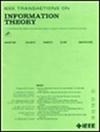Derandomizing Codes for the Adversarial Wiretap Channel of Type II
IF 2.9
3区 计算机科学
Q3 COMPUTER SCIENCE, INFORMATION SYSTEMS
引用次数: 0
Abstract
The adversarial wiretap channel of type II (AWTC-II) is a communication channel that can a) read a fraction of the transmitted symbols up to a given bound and b) induce both errors and erasures in a fraction of the symbols up to given bounds. The channel is controlled by an adversary who can freely choose the locations of the symbol reads, errors and erasures via a process with unbounded computational power. The AWTC-II is an extension of Ozarow’s and Wyner’s wiretap channel of type II to the adversarial channel setting. The semantic-secrecy (SS) capacity of the AWTC-II is partially known, where the best-known lower bound is non-constructive and proven via a random coding argument that uses a large number (that is, exponential in blocklength二类对抗性窃听信道的非随机编码
II型对抗性窃听信道(AWTC-II)是一种通信信道,它可以a)读取到给定范围内的一小部分传输符号,b)在给定范围内的一小部分符号中诱导错误和擦除。信道由对手控制,对手可以通过无限的计算能力自由选择符号读取、错误和擦除的位置。AWTC-II是将Ozarow和Wyner的II型窃听通道扩展到对抗性通道设置。AWTC-II的语义保密(SS)能力是部分已知的,其中最著名的下界是非建设性的,并通过随机编码参数证明,该参数使用大量随机比特(即块长度n的指数)来描述随机代码。在这项工作中,我们建立了一个新的非随机化结果,其中我们通过仅使用$O(n^{2})$随机位的非建设性随机码匹配已知的下界。与完全随机码不同,我们的非随机码采用了有效的编码算法,并受益于一些线性结构。我们的非随机化结果是随机伪线性码的一种新应用——这是一类非线性码,最初是为AWTC-II设置之外的应用而提出的,它具有k-独立码字,其中k是设计参数。作为我们分析中的关键技术工具,我们为具有有限独立性的随机变量和提供了一个新的集中不等式,以及一个类似于Goldfeld, Cuff和Permuter的软覆盖引理,适用于具有k-wise独立码字的随机码。
本文章由计算机程序翻译,如有差异,请以英文原文为准。
求助全文
约1分钟内获得全文
求助全文
来源期刊

IEEE Transactions on Information Theory
工程技术-工程:电子与电气
CiteScore
5.70
自引率
20.00%
发文量
514
审稿时长
12 months
期刊介绍:
The IEEE Transactions on Information Theory is a journal that publishes theoretical and experimental papers concerned with the transmission, processing, and utilization of information. The boundaries of acceptable subject matter are intentionally not sharply delimited. Rather, it is hoped that as the focus of research activity changes, a flexible policy will permit this Transactions to follow suit. Current appropriate topics are best reflected by recent Tables of Contents; they are summarized in the titles of editorial areas that appear on the inside front cover.
 求助内容:
求助内容: 应助结果提醒方式:
应助结果提醒方式:


